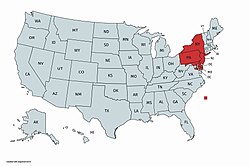Middle Atlantic States
| Mid-Atlantic Region | |
|---|---|
 |
|
| Composition | |
| Metropolitan areas | |
| Largest city | New York City |
| Area | |
| • Total | 191,308.5 sq mi (495,487 km2) |
| Population (2008 est.) | |
| • Total | 57,303,316 |
| • Density | 300/sq mi (120/km2) |
| GDP | |
| • Total | $2.962 trillion (2007) |
The Mid-Atlantic, also called Middle Atlantic states or the Mid-Atlantic states, form a region of the United States generally located between New England and the South Atlantic States. Its exact definition differs upon source, but the region often includes New York, New Jersey, Pennsylvania, Delaware, Maryland, Washington, D.C.. The Mid-Atlantic has played an important role in the development of American culture, commerce, trade, and industry.
It has been called "the typically American" region by Frederick Jackson Turner. Religious pluralism and ethnic diversity have been important elements of Mid-Atlantic society from its settlement by Dutch, Swedes, English Catholics, and Quakers through to the period of English rule, and beyond to the current day. After the American Revolution, the Mid-Atlantic region hosted each of the historic capitals of the United States, including the current federal capital, Washington, D.C.
In the early part of the 19th century, New York and Pennsylvania overtook Virginia as the most populous states and the New England states as the country's most important trading and industrial centers. Large numbers of German, Irish, Italian, Jewish, Polish, and other immigrants transformed the region, especially coastal cities such as New York City, Newark, Philadelphia, Baltimore, and Washington, D.C., but also interior cities such as Pittsburgh, Albany, and Buffalo.
...
Wikipedia
